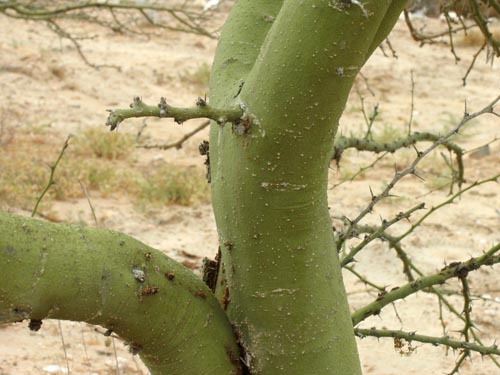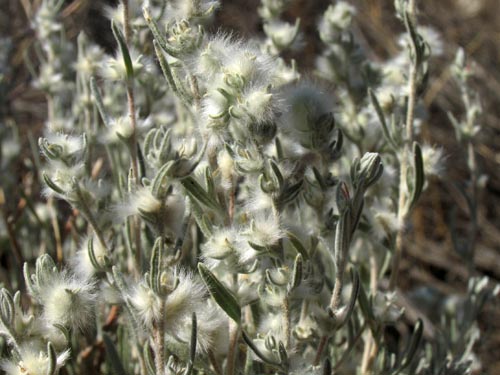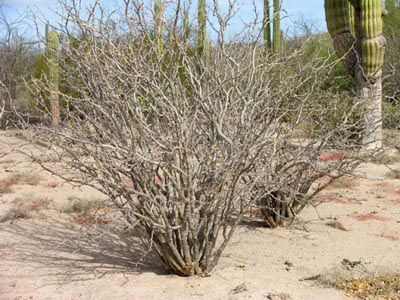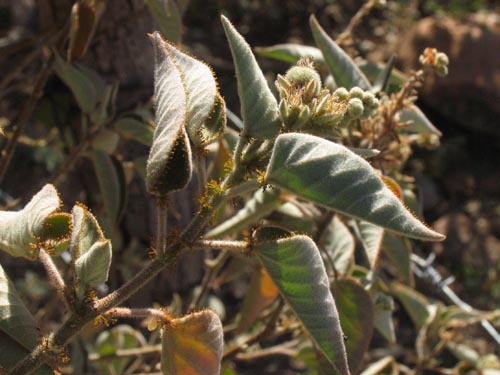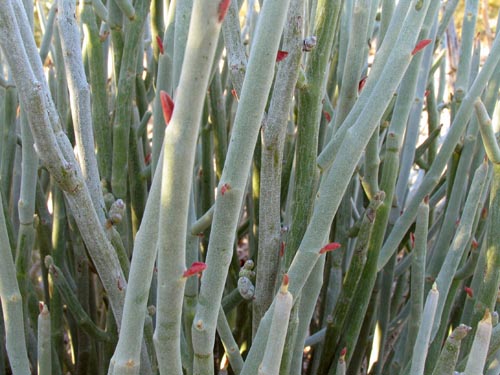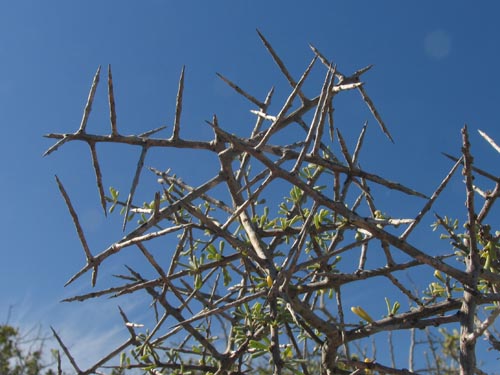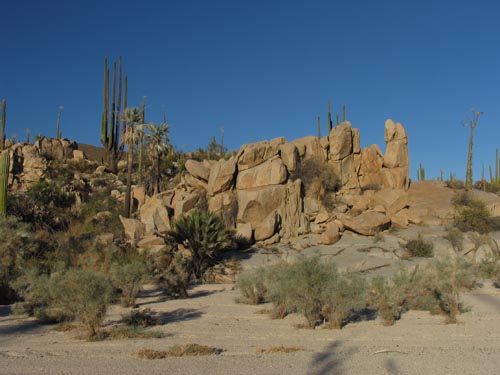
Arroyo near Cataviña, BC
Sixty percent of the Baja Peninsula is classified as part of the Sonoran Desert, one of North America's four deserts. In spite of the harsh environment, it is also North America's most diverse desert.
Learn about the incredible variety of habitats, plants and animals and how life has adapted to live in this harsh place.
You'll find links to the class handouts used at ISSI (Intensive Spanish Summer Institute) here and in the ISSI archives. You can also link to the vocabulary list for this topic or see the spanish translation by clicking on individual red words in the text below.
What is a Desert?
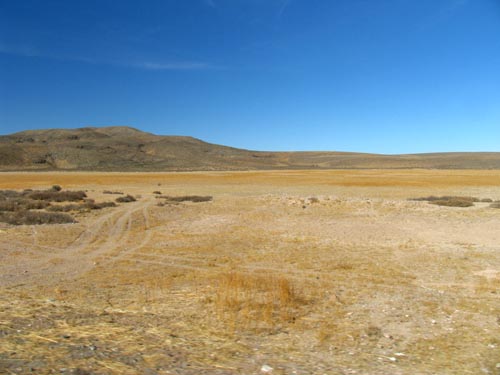
It would be difficult to find any one description that would fit all of the twenty or so deserts found on our planet because each one is a unique landscape. While an expanse of scorching hot sand dunes with the occasional palm oasis is the image that often comes to mind for the word desert, in fact, only about 10% of the world’s deserts are covered by sand dunes. The other 90% comprise a wide variety of landscapes, among these cactus covered plains, foggy coastal slopes, barren, and high-altitude, snow-covered plateaus. However, one characteristic that all deserts share is aridity—any place that receives less than 10 inches (25 centimeters) of rain per year is generally considered to be a desert and the world’s driest deserts average less than 10 mm (3/8 in.) annually.
But why are deserts dry? There are a number of factors involved, including: low rainfall; high temperatures; clear skies; high rates of solar radiation and evaporation; and desiccating winds. Soils low in organic content and high in minerals also decrease moisture retention. Geography plays an important role as well. Many of the world’s hot deserts are located around 30° north or south of the equator while other deserts, such as the Gobi in Mongolia, are formed as a result of being in the rain shadow of a significant mountain range. High temperatures are not requisite for desert formation and therefore not all deserts are hot—the Gobi, Argentina’s Patagonian desert and the Taklamakan Desert of China are examples of cold deserts, where the only moisture falls in the form of winter snow. The polar ice caps, where all moisture is locked up in the form of ice and snow, are also considered deserts.
Desert: “A place where lack of water is severely limiting to living things most of the time.”
Arizona Sonora Desert Museum
Baja California’s Desert Regions
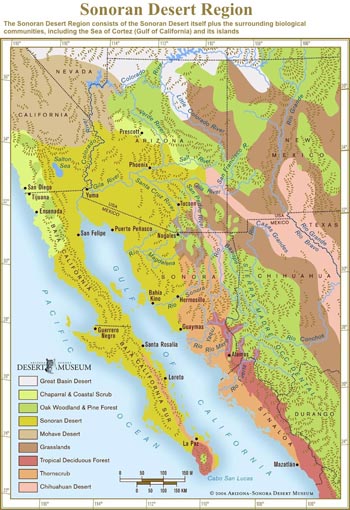 Over 60% of the Baja California peninsula falls within the boundaries of the hot, dry Sonoran Desert. In the summer, average temperatures can exceed 104° F with a humidity of <10% in some regions and around-the-clock temperatures of 90-100° F are not uncommon. Daily temperature fluctuations during other seasons of the year can exceed 50° F (e.g., ranging between 35° and 85° F). Rainfall is scarce and sporadic, with an annual average of 12-30 cm (4.7-12 inches). There are two rainy seasons, December-March and July-September, with the northern peninsula dominated by winter rains and the south by summer rains. Some areas experience both seasons, while in other areas, such as parts of the Gulf coast region, rain may fail for years on end.
Over 60% of the Baja California peninsula falls within the boundaries of the hot, dry Sonoran Desert. In the summer, average temperatures can exceed 104° F with a humidity of <10% in some regions and around-the-clock temperatures of 90-100° F are not uncommon. Daily temperature fluctuations during other seasons of the year can exceed 50° F (e.g., ranging between 35° and 85° F). Rainfall is scarce and sporadic, with an annual average of 12-30 cm (4.7-12 inches). There are two rainy seasons, December-March and July-September, with the northern peninsula dominated by winter rains and the south by summer rains. Some areas experience both seasons, while in other areas, such as parts of the Gulf coast region, rain may fail for years on end.
Permanent above-ground water reserves are scarce throughout most of the peninsula but ephemeral, seasonal pools and rivers do appear after winter storms in the north or summer storms (hurricanes and thunderstorms—chubascos) in the south. There are also a number of permanent oases, most often formed where aquifers (subterranean water) rise to the surface. Pacific coastal regions along the entire peninsula enjoy the relatively cooling effects of fog throughout the year, generated as a result of the cool California Current; in some years, this may be the only source of moisture for wildlife.
Life in the Desert?
Plants and animals have developed many adaptations to deal with the desert’s harsh environment. Organisms depend, above all, on water for survival and have developed a wide variety of characteristics and strategies for obtaining and retaining water. No sane, seasoned hiker would willingly face the challenge of the midday, desert sun in August, and if s/he had to, surely would not do so without first donning sturdy shoes, protective clothing, a wide-brimmed hat and sunscreen and carrying a water bottle. In the same manner, desert plants and animals have their own protective coverings and behaviors. Cacti, with their expandable ribs, as well as other succulent plants, are masters of water storage and retention. Dense hair, spines, waxes and gummy exudates all protect plant foliage from damaging UV exposure, slow down water loss and help prevent overheating. Animals may sport large ears to help dissipate body heat or have the ability to recycle water from bodily wastes. Others will avoid the harsh environment altogether, migrating, hibernating or living a nocturnal lifestyle in which they spend their daytime hours in the shade or in underground burrows. Some plants avoid energy expenditure for special adaptations by living only a brief lifecycle in which they sprout, flower and go to seed within a few short months or seasons, dying back before the harsh weather begins.
In more temperate regions of North America, where water is relatively abundant, plant and animal life appears to be lush in comparison to the desert regions. However, the Sonoran Desert is far from being a sterile, lifeless region. Relatively speaking, it is one of the wettest North American deserts where the dual rainy seasons, combined with the lack of hard freezes in winter, have led to an overall high diversity of plant and animal life—life that not only survives, but thrives in the desert.
Plant Adaptations
Adaptations such as green, photosynthetic bark, silky hairs, silvery hairs or bark, deciduous leaves, glandular hairs, a chalky surface, succulent tissues, spiny branches, thorns, and spines are just some of the more obvious adaptations that help plants survive in the harsh desert environment. They help keep plants cool, reduce loss of water and other resources and protect against browsing. Annual plants can escape the worst weather by sprouting, blooming, going to seed and dying within a few months to about a year. Perennial plants die back to a fleshy or woody underground stem or tuber. Shrubs and trees in the desert tend to be drought deciduous, losing their leaves when water is scarce and becoming dormant until sufficient rain or moisture "wakes" them up. Most plants employ a variety of these adaptations.
File Downloads
Bajar documentos
- Sonoran Desert Class Handout (ISSI)
- Sonoran Desert Presentation (ISSI)
- Presentación del Desierto Sonorense (ISSI)
- Vocabulary list (ISSI)
- Presentación sobre el Berrendo Peninsular
- Informe del Berrendo Peninsular (SEMARNAT, 2009)
Links
Enlaces
Arizona Sonoran Desert Museum (ASDM) English & Spanish resources
ASDM Center for Sonoran Desert Studies
ASDM Digital Library
ASDM Desert Fact Sheets
Desert Bighorn Sheep Fact Sheet (S.D. Zoo)
Desert USA
Flora of Baja California
Pronghorn Antelope Fact Sheet (S.D. Zoo)
San Diego Natural History Museum (SDNHM)
TerraPeninsular (site in English)
Wildcoast (their site in Spanish CostaSalvaje)
More links to articles and videos can be found in the ISSI archive

